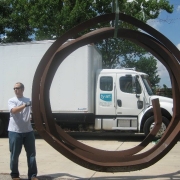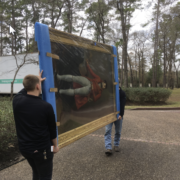The Science of Moving Art Work
Ideally, a transport crate for an artwork should
guarantee, in its interior, environmental conditions
identical to those in a museum, even when external
influences are at their harshest. The relevant negative
external influences likely to be met with in a museum are
summed up in a list entitled “Ten Agents of Deterioration”.
The transport crate itself should offer especial protection
against climatic fluctuations, sudden impacts and
vibrations. The other “agents of deterioration” – such as
fire, theft, flood etc. – should be excluded by means of
securing procedures carried out prior or parallel to the
crating.
CLIMATE FLUCTUATIONS
How effective the crate is against climatic fluctuations,
impacts and vibrations can be tested in environment
labs. Product standards and guidelines prescribe the
stress tolerances in these regards. Super-sensitive
sensors are used to monitor the crates’ reactions to
fluctuations in environmental conditions. The guideline
ASTM 4169 (“Standard Practice for Performance Testing
of Shipping Containers and Systems”) defines the basis
for all packing tests.
CLIMATIC TESTS
As is shown, for example, very impressively in the film Das
Atmen der Bilder (“The Breathing of Paintings”) by Volker
Schaible, climatic fluctuations and the stress and strain
that they impose on the materials of artworks are so slight
as to verge on being static. Nevertheless, very powerful
forces come into play with even the slightest fluctuation.
Were this not the case, we would not see flaking of paint
occurring even at a relative atmospheric humidity of <50
%. It is correspondingly important, then, to ensure stable
climatic conditions during the entire process of transport.
The climatic stability of the transport crate should
be tested before its use. The topic of climatic tests is
specifically addressed in the product standard DIN EN
ISO 2233: 2001 and the guideline ASTM D4332.
STANDARDIZATION
Normally the crates and other packaging undergo a standardized
pre-conditioning process to prepare them for the
climatic tests. They are introduced into climatic test
chambers which induce variations in both temperature
and atmospheric humidity. Temperature and humidity
gauges placed at various points inside the crate are
used to observe any changes brought about by these
variations. From the data thus gathered it can be inferred
how long climatic conditions will stay stable in the crate
during transport.
CHOOSE A SPECIALIZED TRANSPORTER
If you are unfamiliar with the transportation of art pieces, we recommend that you use a specialized company that has all the necessary equipment and expertise. These professionals are specialized in the packaging and handling of precious and fragile objects. Some companies also offer specific types of transport in adapted vehicles equipped with performance suspensions or interior upholstery. Here at TyArt transporting artwork is our specialty!
ABOUT THE BUSINESS:
While dealing with artwork, it is best to seek professional help. TyArt is an art handling company, well known and recognized for its authentic services. We offer various services like an art installation, art carting, art storage, and picture hanging. For more information, contact us at 713-869-4044, write a mail to tyart@tyart.com, or fill the contact form.






Leave a Reply
Want to join the discussion?Feel free to contribute!